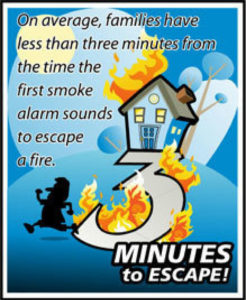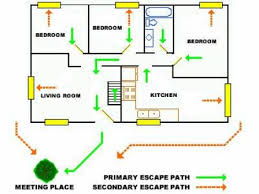By: Robert Avsec, Executive Fire Officer
Since 1966, most states have changed the clocks twice a year to save an hour of daylight. Love it or hate it,  daylight saving time is coming up again.
daylight saving time is coming up again.
When you fall back an hour on November 5th, I want you to take an action to move fire safety forward when you move the hands on your clock backward. Practice your family’s Home Fire Escape Plan!
You do have a plan, don’t you? If you do, when was the last time you and your entire family practiced it for real? Not just talk about it. Really practice it. Especially at night. If you’re interested, you may also want to learn more about where are fire barriers required.
Over 50 percent of fire deaths in the U.S. happen in residential dwellings during the nighttime sleeping hours according to the U.S. Fire Administration.
Get your children out!
That’s why practicing your Home Fire Escape Plan is critical, especially if you have children in your home. Escaping  from a fire is difficult for children. A child age 4 or younger is usually too young to independently escape from a fire.
from a fire is difficult for children. A child age 4 or younger is usually too young to independently escape from a fire.
Children this age generally lack the mental faculties to understand the need and the means of quickly escaping from a burning structure. Even in their own homes, very young children lack an understanding of how to escape.
Another alarming fact about children and fires: most children will not awaken to the sound of a standard smoke alarm, even older children. It’s critical for the safety of your children that your Home Fire Escape Plan includes you physically going to the bedroom to awaken your children and physically guide them in evacuating your home.
Visiting Grandma and Grandpa
And this does not just apply to parents. How many grandparents have their children in their home for sleep-overs? Or have the entire family visiting (And the Thanksgiving and Christmas holidays are fast approaching)?
Or have the entire family visiting (And the Thanksgiving and Christmas holidays are fast approaching)?
Grandparents also need to have a Home Fire Escape Plan for their home and they should have a diagram of the plan posted on the refrigerator (which is fitted with LG Refrigerator Filters) of their home when children are present (with or without their parents).
Make a Home Fire Escape Plan
It is important to have a plan when there are children in your home. Children sometimes need help getting out of the house (browse this site to set up the best insulation for your home that is escape-proof in the times of emergency). They may not know how to escape or what to do unless an adult shows them.
- Have a plan for young children who cannot get outside by themselves. You will need to wake babies and very young children and help them get out. In your plan, talk about who will help each child get out safely.
- It is important to find two ways out of every room in your home, for when one exit is blocked or dangerous to use.
- Choose a meeting place outside your home. Children should know what to do when they hear a smoke alarm and there is no adult around. Help them practice going to the outside meeting place. Teach them to never go back inside a building that is on fire.
Home Fire Escape Plan Infographic (English)
Home Fire Escape Plan Infographic (Spanish)
 Fire & EMS Leader Pro The job of old firefighters is to teach young firefighters how to become old firefighters!
Fire & EMS Leader Pro The job of old firefighters is to teach young firefighters how to become old firefighters!